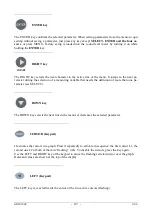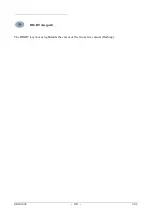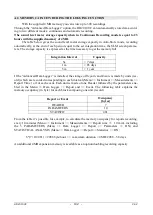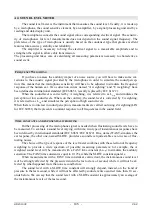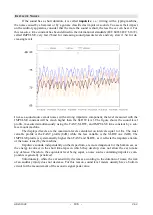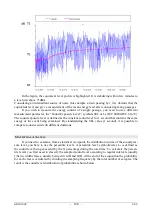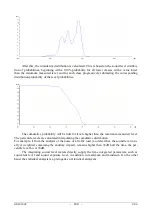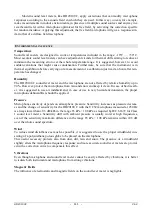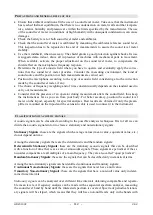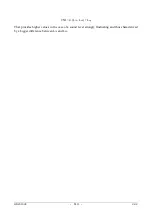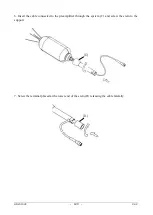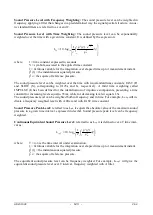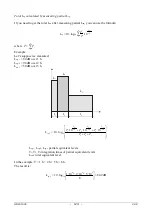
HD2010UC
- 110 -
V4.2
N
OISE
D
OSE
The measurement of the “Dose” of noise is used in the field of noise monitoring in a working
environment, meant as a percentage fraction of a maximum daily exposure to noise. The organiza-
tions taking care of safety in working environments have defined some standards for the measure-
ment of the noise dose considering the energy content of sound pressure and comparing it with a
maximum daily equivalent level (over an 8-hour time interval) that is, in Italy, equal to 85 dBA (A
weighted equivalent level) when no hearing protection is available.
ISO 1999 standard, considering only sound energy, sets out that an increase of 3 dB in the
sound level halves the exposure time, to keep the dose equal. Italy applies ISO 1999 definition.
Health corporations in other countries have adopted a different principle that takes into account the
ear recovery times during pauses and allow to increase the level by 4 dB (DOD) or 5 dB (OSHA)
before halving the exposure time.
A
COUSTIC
F
IELD
Sensors and transducers in general are designed not to disturb the physical quantity to be
measured. Exactly as a thermistor would limit to the minimum the temperature disturbance caused
by its presence, also the microphone is designed not to alter heavily the acoustic field where it
works. The alteration of acoustic field becomes important at frequencies corresponding to sound
pressure wavelengths comparable to the microphone dimensions (diffraction phenomenon). For ex-
ample, with 10 kHz, sound pressure wavelength equals about 3.4 cm, comparable with the dimen-
sions of a typical microphone.
Essentially, there are two types of acoustic fields: the “free field” and the “diffuse field”. The
field is defined “
free
” when the sound level decreases by 6 dB doubling the distance from the
source. This condition is usually met with a good approximation at a distance from the source high-
er than its bigger dimension and, in any case, higher than the bigger wavelength of the generated
noise.
The free field is significantly disturbed by the closeness of rigid walls, capable of “reflecting”
sound levels comparable with those due to the acoustic pressure waves coming directly from the
source.
The acoustic field in an environment where sound waves reflected by walls are dominant and,
therefore, where the sound level is determined by sound pressure waves coming from all directions,
is called “
diffuse field
”. While measurements in indoor environments are usually treated as diffuse
field measurements, those outdoor are generally treated as free field measurements.
Since the microphone has dimensions comparable to the highest frequencies of the sound spectrum,
it is designed to get an optimized response for a given acoustic field.
There are three types of microphone: for free field, diffused field and pressure.
The
microphone for free field
is designed to have a constant sensitivity at any sound field frequency
for sound signals coming from the front side, making automatic adjustments to high frequencies to
compensate the increase in pressure at the membrane level, due to its presence.
The
microphone for diffuse field
is instead designed to have a constant sensitivity at all frequencies
for sound signals coming from all directions.
The
microphone for pressure measurements
is used for laboratory measurements even though, hav-
ing a characteristic similar to that of a microphone for diffuse field, might also be used in reverber-
ant fields.
When a diffuse field microphone is used in free field, it usually provides precise values when it is
oriented at 70° - 80° compared to the sound source. If it is pointed to the source direction, it pro-
vides too high values, mainly at high frequency. Vice-versa, a microphone optimized for the free
field will provide too low values when measuring in reverberant fields and in all cases in which it
will not be oriented towards the sound source.
Summary of Contents for DeltaOHM HD2010UC
Page 2: ...HD2010UC 2 V4 2 ...
Page 129: ...HD2010UC 129 V4 2 NOTES ...
Page 130: ...HD2010UC 130 V4 2 NOTES ...
Page 131: ......


